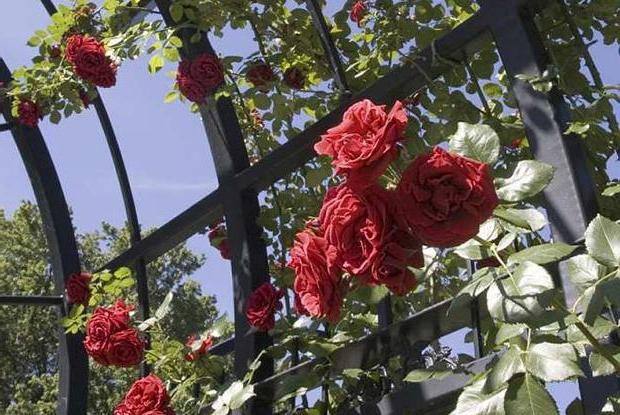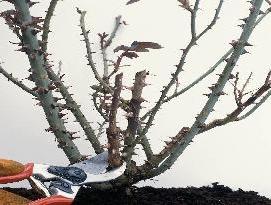How to cutting cutting roses in summer. Growing and breeding climbing roses
How to propagate climbing roses.Rose Queen of Flowers. Climbing roses are used for vertical gardening, arches, trellis and decorative columns. With their help, you can create a lot of interesting compositions on your country site. In this article we will explain how to propagate climbing roses.
Climbing roses are propagated in three ways: cuttings, layering and budding.
Reproduction of a climbing rose by cutting. Cutting as a breeding method climbing roses most effective. Preparation of cuttings should be made in September in large-flowered roses and after flowering in small-flowered. Shoots 17-20 cm long are cut into cuttings that contain 3-4 buds.
The lower cut of the cutting should be made at an angle immediately after the lower bud. Slightly departing from the upper kidney, make a direct cut. The lower leaves of the stalk must be removed, the rest cut in half.
Cuttings can be rooted in two ways: in the water and in the ground. If the first method is chosen, then you need to put the cutting in purified water. Plain water can cause rotting of the forming roots, so it is better to boil it.
Usually the roots of the desired length appear in 20-30 days and the stalk can be planted in a flower pot. Until next spring, the stalk should be left in the room where you should look after it as if you were at home with flowers.
When rooting in the substrate there is no problem of rotting of the roots. A vertical hole is made in the pot with a diameter twice the diameter of the cutting. Sand is poured into such a hole and a cutting is inserted. Sand, the first time must be constantly wet. After the stalk is planted it needs to be covered with a glass jar. Before you put the pot with the handle on the window, you need to shade the jar, covering it with a cloth.
Reproduction of climbing roses layering. If cuttings are chosen as a method of breeding climbing roses, then in the fall or spring, choose a good shoot and dig a groove under it that will be 10-15 cm wide. The depth of the groove should not exceed the spade bayonet. They put humus on the bottom and, filling it with a thin layer of earth, lower the escape.
On the shoot, before it prikupayut, you need to incise the bark under the kidneys. So the formation of the roots should happen much faster. Prikopanny escape need to pin to the ground in several places. The end of the shoot must stand vertically.
Budding as a method of breeding climbing roses. Budding is less popular with florists. The thing is that only some varieties of climbing roses can be propagated this way.
Budding produced in August - September. For this method, they take a sleeping eye and, after cutting the bark in the area of the root of the rosehip, insert it. After the budding area is wound with tapes of film. Hooking eyes is possible only with good contact, which is achieved by tightly tying the budding point.
Before planting cuttings in open ground you need to dig a groove and put sand on its bottom. The cuttings are added in the groove at a distance of 10-15 cm from each other. The bottom sheet of the cutting should be at ground level.
Care for the rooted cuttings of a climbing rose consists in watering, weeding and loosening the soil. In winter, the cuttings are covered with peat or loose earth. Spruce spruce branches or special materials can cause the death of cuttings due to the lack of air flow to the plants.
And arches, balconies or gazebos give preference to a climbing rose because of its amazing compatibility with small forms of architecture.
Reproduction occurs better in areas with a mild and warm climate. poorly suited for its breeding on a large scale, but on gardening or garden plots it survives on forest-steppe nonchernozem soils.
Propagation of rose climbing clips
One and flower propagation methods are layouts. In the spring, a strong shoot is selected, from which a hole in the soil is dug up to 20 cm wide. At the bottom of the humus put and put himself escape. Pre-cuts in several places are cut for the quick appearance of the roots. During the whole summer period it is plentifully watered The next spring, he appears roots. Now a new plant is separated from the parent. The young rose is transplanted to a place well lit by the sun. It is very important the first year to prevent its flowering.
Reproduction of climbing rose cuttings
It is necessary to choose non-mature up to 0.5 cm thick and up to 20 cm long in September. Cut the stalk with 4 buds from the middle of the shoot. Remove the two lower leaflets, and leave the kidneys. A groove is dug out with one edge vertically, at the bottom of which sand is poured in the river. Now the cuttings are located vertically at a distance of 15 cm from each other and are pressed against the edge. Earth is compacted and watered. Rose propagation climbing gear requires careful site selection. Light should be soft and in sufficient quantity, the temperature required for root germination is at least + 20 C. Further care involves only weeding, watering and loosening the soil.

Climbing rose, the reproduction of which can be productive both in spring and autumn, prefers places where roses still did not grow. She loves feeding, which can be done up to five times during the growing season, requires pruning and garter, mulching. Cutting off the faded branches of a bush, it is possible to stimulate new flowering. In winter, the plant is covered.
Pruning

In the second year of life, pruning is carried out in the spring. Removes all damaged and dry shoots. Pruning should be careful not to damage the young shoots from the root or old shoots. Otherwise, the bush will not bloom. To form a flower, pruning is done by no more than a third of the length. Removed thin, long and underdeveloped shoots. To rejuvenate roses, they cut out shoots at the age of 4-5 years at the base, leaving only strong three-year-olds.
Diseases
The scourge of climbing roses is a fungal disease, in particular. Also at the end of the winter period, a bark cancer (coniotriium) may occur in a flower.
Correctly carried out breeding of climbing roses, good care, light and heat will settle in your garden a very beautiful and fragrant flower. As befits the queen of flowers, climbing rose will be a real pride and decoration of any site.
How to propagate roses by cuttings? Currently, there are several breeding options, but amateur gardeners prefer to use the proposed method, since it is quite simple. Such a method is concluded in cutting pink cuttings with three buds, as well as their further rooting. Today we invite you to understand the question of how cuttings are carried out correctly and whether it is possible to root roses in water.
The basic rules and nuances of how to propagate roses by cuttings. Video and detailed instructions.
For grafting, it is preferable to take the upper or middle part of a healthy, strong, woody shoot, just starting to bloom or already ending flowering. With the help of a special garden secateur, it is necessary to cut shoots from it, ten to fifteen centimeters in length. At the same time on each shoot should be three buds. Cut in such a way that the lower cut is located directly under the kidney (it should be done at a 45-degree angle). A straight upper cut should be located above the kidney. When growing, it is also assumed that the leaves are partially removed in order to reduce evaporation. The bottom sheet must be removed completely, and the top shortened by one third.Rules for planting and breeding climbing roses cuttings.
 Rose bushes need enough light, moderate watering and spraying, while the optimum temperature for them is within 25 ° C. For reproduction can be used woody, last year's cuttings, or new, semi-woody. So, the main secret how to propagate roses by cuttings- this is the correct rooting of shoots, which can be done in two ways:
Rose bushes need enough light, moderate watering and spraying, while the optimum temperature for them is within 25 ° C. For reproduction can be used woody, last year's cuttings, or new, semi-woody. So, the main secret how to propagate roses by cuttings- this is the correct rooting of shoots, which can be done in two ways: - Rooting in the soil. For this purpose, shoots are slopingly planted on a special garden bed (in the case of spring or summer grafting), or in pots filled with a substrate of sphagnum, peat and sand (there must also be added fertile soil). Then the roses must be covered with a glass jar to create a small greenhouse. Cuttings need to be watered if necessary, before planting the shoots in the pot should be added coarse-grained, thoroughly washed river sand. It is precisely into it that the cutting is stuck, and the sand does not allow it to rot as a result of excess moisture. After the appearance of young pink shoots, you can occasionally lift the jar. Rooting in the water. In this case, the escape is placed in a container filled with boiled water, and placed in a moderately lit place. Sometimes the water should be changed and topped up, and after about 25 days the cuttings will take root, then they can be transplanted into the ground. The main disadvantage of this method is the lack of oxygen, and therefore it is unsuitable for certain types of roses.
The technology of planting cuttings of climbing roses in the cuttings.
Before, how to propagate climbing rose cuttings, make sure that the bed is quite tight, so that water does not evaporate from it, then the shoots do not have to be constantly watered. It is necessary to check the cuttings and water them once a week (sometimes even two weeks), in particular, if the cuttings are in the shade throughout the day. At the end of the summer, pink cuttings will take root, and therefore the film from the greenhouse can be removed, only the plants will need to be ventilated and trained to light. To protect the flowers from autumn frosts, it is preferable to cover them with lutrasil. The most difficult for climbing roses is the first wintering. To do this, they must be placed in an air-dry shelter, or covered with several layers of lapnik and lutrasil.
Found a typo? Select a fragment and send it by pressing Ctrl + Enter.
Having planted one bush of roses and having waited for flowering, it will be desirable to decorate with pink garlands and other places in the garden. Make it easy. Climbing roses breed well. In nurseries, specialists vaccinate them on dogrose. At the cottage, it is easier to grow a new bush of climbing roses from cuttings, cutting them off from a bush growing in the garden. Seed climbing roses are not bred.
Green grafting is the easiest way to breed climbing roses. Procurement of cuttings start when buds are formed (which is better) or immediately after the first flowering.
Cutting shoots spend in the early morning hours when they are most saturated with juices. It is preferable to cut off half-lifted shoots, fully matured are less suitable and fat and young herbaceous are not suitable at all.
Immediately after cutting, cuttings 5–8 cm long with 2–3 leaves are cut from the central part of the shoots. The lower cut is done obliquely under the kidney, and the upper one is 1 cm above the kidney. To reduce evaporation, cut off the bottom sheet and part of the top sheet. It is necessary to treat the leaves carefully, it is impossible to completely remove, without them, the cuttings of the roots do not form.
Usually climbing roses root well. However, if there is no certainty that the cuttings will give roots, before planting, you can powder the tips of the root. Or, for 18–20 hours, immerse them (not higher than 1.5 cm) in a 0.01% solution of heteroauxin, but then rinse with clean water before planting.
Planted cuttings of climbing roses in a box or on a garden bed. The place is chosen where the sun's rays will fall early in the morning or in the evening. 8–10 cm of sod-humus soil are poured on a bed or in a box, over a 3–4 cm mixture of equal parts of sand and peat. Planted cuttings, buried by 1.5 - 2 cm. On the garden bed covered with glass or plastic jars, and the box is covered with foil.
After planting, moisten the cuttings of climbing roses several times a day, preferably from a spray bottle, keeping the humidity at 80 - 90%. Fallen leaves are removed. After 2 - 3 weeks, callus appears, and a month later the roots form. Banks or film is removed, and the cuttings are grown, feeding every 2 weeks with a solution of ammonium nitrate or urea (1.5 - 2 g per 1 l of water).
Over the summer, the shoots of rooted young cuttings do not have time to ripen, so they are covered with fallen leaves or sawdust. The box can be transferred for the winter to the basement and prikopat in wet sand. Spring is planted on permanent place. Grown so own-rooted plants do not have to be protected from the hips, which causes a lot of trouble for grafted roses.
Nitrogen-rich cuttings root worse. Therefore, climbing roses, selected for grafting, in the spring should not be fed with nitrogen fertilizers.
Climbing roses are beautiful in the bouquet. To prolong the life of flowers in a vase, they should be cut early in the morning or in the evening. Buds should be chosen half open, and flowers just bloomed.
After cutting the roses, you should do the following with them.
1. Immediately lower the stems into a bucket of water, plunging to the flowers, and hold in a cool place for 4 to 6 hours, you can in the refrigerator at a temperature of 6 to 8 degrees.
2. Fill the vase with boiling water at room temperature and dilute several crystals in it. citric acid. Roses will stand even longer if you add a nutrient solution consisting of 20 g of granulated sugar, 0.2 g of boric acid and 0.2 g of potassium permanganate per 1 l of water. In addition, the life of cut flowers can be extended with a tablet of activated carbon or aspirin.
3. Before placing the bouquet in a vase, at the water level, remove the leaves and thorns.





